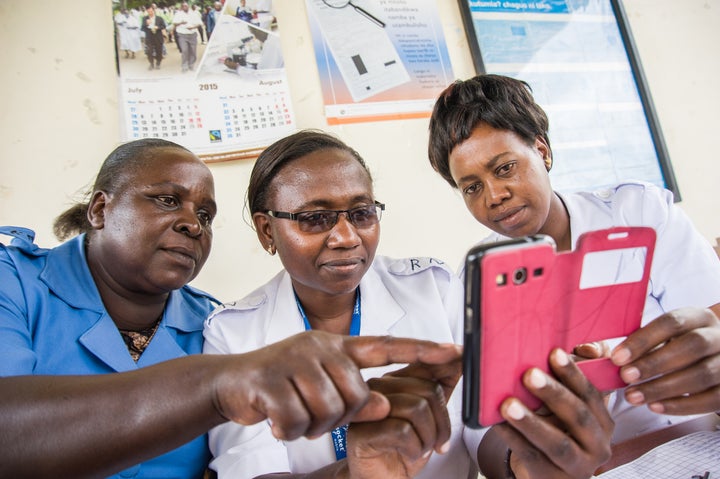
Monday will mark the start of World Immunization Week, an annual campaign run by the World Health Organization and many partners to focus public attention on the importance of vaccination for all—particularly those who are consistently excluded.
This time last year, I shared a set of extraordinary new innovations that can improve and accelerate our ability to deliver vaccines to the world’s hardest-to-reach communities. As our ability to translate science into practical solutions grows, new technologies, and thinking more creatively about existing ones, are helping to give us ways to save even more lives through immunization. I’d like to share four more of them with you that have the promise to be game changers:
Vaccine Delivery...by Drone
Imagine you’re a healthcare worker in a developing country, responsible for ensuring there are enough medical supplies in your district. Villages are far apart, roads wash out during the rainy season, and it takes hours to get from point A to point B. How do you make sure you get fragile vaccines to the clinics right before they need them?
Here’s an imaginative way: Deliver them by Unmanned Aerial Vehicles (UAVs), or drones. Beginning with a 2016 pilot program in Rwanda, the Government of Rwanda partnered with California-based Zipline to unveil the world’s first national drone delivery service, enabling vaccines and medical supplies to reach remote communities quickly and reliably.
Here’s how it works: A vaccine manager places an order via text message on a mobile phone. Zipline receives the order at their "Nest" (distribution center), and then instructs one or more “Zips” (drones) to make the delivery. Each Zip can fly almost 100 miles roundtrip, through wind and rain, to deliver vaccines and other medical supplies with pin-point accuracy, in record time.
The project is going so well that the Rwandan government is thinking about expanding the service by using drones to put vaccines within easy reach for all of Rwanda's 11 million people. While this bigger move is still being planned out, Rwanda has already shown how delivery and infrastructure problems can be easily solved by a combination of visionary leadership and cutting-edge technology.
Improving our Vaccine Intelligence
As you know from experience, having an uncomplicated picture of which supplies are where, and when more are needed, is a basic requirement for any logistics system—whether its reliably delivering vaccines to remote healthcare clinics, or just making sure you don’t run out of milk at home. The absence of this information will inevitably result in running out, having too much, or wasting, supplies. If it’s just the milk in your fridge, you’ll live. If it’s a vaccine or other medicine, lives are put at risk.
Enter the Electronic Vaccine Intelligence Network—or eVIN. Developed by a local firm, Logistimo, and recently launched in India by the United Nations Development Program (UNDP) in partnership with Government of India, eVIN provides healthcare workers with real-time information on vaccine stock, storage and fridge temperatures. All of it is made possible by simply connecting mobile phones at health clinics with data dashboards used by managers at local and national levels. And with a simple Internet connection, can be viewed online anytime and anywhere in the world. eVIN, and other similar efforts in parts of Africa and Asia, is based on the same concept of turning on bright lights in a dark room—it gives immunization managers the ability to see into their system so they know when to buy more vaccines, how much to order, and even which fridges need to be fixed to maintain the vaccine cold chain. In a little over a year since its launch, eVIN has achieved more than 99 percent reporting rates across more than 10,000 cold chain facilities in 11 Indian states—covering 17 million children. The network also collects more than 2 million logistics and 100 million temperature readings each month, helping to achieve more than 99 percent availability for all 11 vaccines in the program. The data visibility produced by eVIN reduces vaccine stockouts, and by extension, ensures that more kids get immunized.
Building 'Smart' Vaccines
Vaccines are one of the most important advancements in public health—yet for generations, the science behind them has remained largely unchanged. Essentially, vaccines mimic infections to train the body’s immune system to respond rapidly when an actual infection occurs. Development of vaccines can take years, and the complexity involved has made it difficult to design vaccines for some diseases.
That’s now starting to change, thanks to advances in the development of RNA (ribonucleic acid) vaccines. In the human body, RNA carries out diverse tasks, and one of its coolest functions is to translate genetic information into proteins. Scientists have long sought to utilize this concept for medical purposes, but up until just a few years ago it was not thought possible.
Moderna and CureVac are two companies that have been working to change that, and with promising results. Both are harnessing the power of so-called 'messenger RNA' (mRNA), which essentially acts as the carrier of encoded 'instructions' that direct cells to make their own custom-tailored proteins that serve as medicine to prevent or fight disease.
Their work represents a huge opportunity for resource-poor countries—and could be a game-changer in fighting global pandemics—because it allows for rapid, low-cost production of vaccines that remain stable, safe and effective without refrigeration.
It’s exactly the type of advancement that matters most in medicine, and from my view, an especially exciting example of how cutting-edge science can be harnessed for the global good.
Mobile Money
Finally, a first-of-its-kind study recently demonstrated a potential innovation to encourage parents to bring their children in for routine vaccinations and do so on time. As part of the Mobile Solutions for Immunization (M-SIMU) trial, parents in villages across western Kenya received text message reminders and small monetary incentives—in some cases less than $1— to adhere to the pediatric vaccination schedule.
Among communities that already had high immunization coverage, the interventions were shown to lift coverage and improve timeliness, offering a potential solution to increase immunization in areas where coverage has stalled, and where the protections extended to entire communities when a high percentage of people are vaccinated—known as herd immunity—are at risk.
Your Voice Matters
World Immunization Week gives parents, health workers, government leaders and others an opportunity to reflect on the amazing work we’ve done thus far, and highlight what remains: more than 19 million children are still un- and under-vaccinated, coverage targets have stalled in many countries, and we are behind on several disease elimination targets globally.
Innovations in medical science designed to help us lead healthier lives only help those who are able to take advantage of them, and making immunization available to everyone is what World Immunization Week is all about. Your voice matters, and I hope you will join me in sharing at least one #VaccinesWork post to your social media channels next week to show your support for the life-saving magic of vaccines, and celebrating the heroic efforts that parents and health workers make every day to protect our children and communities.
